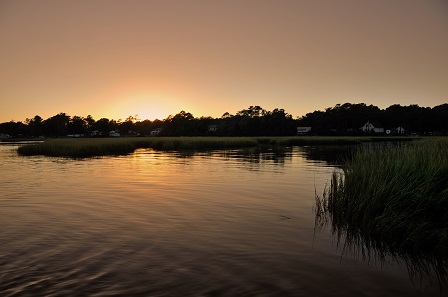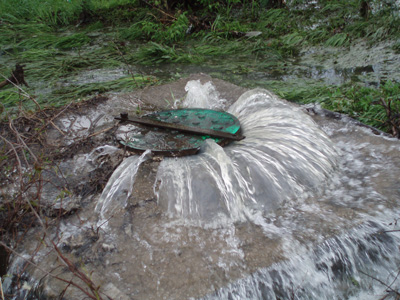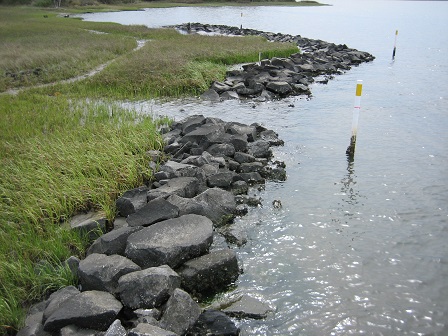AROUND THE NEXT CURVE: Report Considers Estuarine Shoreline Management Strategies

North Carolina’s thousands of miles of estuarine shoreline — edging sounds, bays and other areas where fresh and salt waters meet — are known for their rugged beauty and bountiful wildlife. But as more people move to this inner coast, the region is increasingly experiencing pressures associated with development.
A new report, released by North Carolina Sea Grant and the N.C. Coastal Resources Law, Planning and Policy Center, outlines issues the region will face in the next five years and provides options for managers and property owners.
“The goal of this research was to be forward thinking. We hope the information in the final report provides natural resource agencies, the Environmental Management Commission, Coastal Resources Commission and coastal communities with a snapshot of the resource issues that will become increasingly important to coastal North Carolina,” explains Lisa Schiavinato, Sea Grant coastal law, policy and community development specialist, who also co-directs the Center.
“The report can assist state and local governments as they plan for the future, and prepare to face challenges that may affect coastal economies and resources,” she adds.
The report, Management Strategies for North Carolina’s Estuarine Shoreline, is the result of more than three years of study of emerging management and policy issues for the entire North Carolina coast.
The Estuarine Policy Steering Committee included experts from state agencies, universities and nonprofit organizations, who provided scientific and technical expertise and worked with the Center to develop policy recommendations. See page 14 for a list of members and their affiliations.
“The committee’s work was an excellent example of collaboration,” says John Fear, now Sea Grant deputy director and who had served as a committee member while he was with the N.C. Coastal Reserve Program.
“Staff from state agencies, NGOs and universities worked together to identify the issues and develop recommendations on how best to deal with those issues. I look forward to seeing aspects of the report being utilized.”
This report follows Developing a Management Strategy for North Carolina’s Coastal Ocean, which focused on current and emerging ocean policies. Sea Grant and the Center received requests from the public to conduct a similar study for the state’s estuarine shoreline.
In the estuarine study, four emerging resource issues are highlighted for coastal counties and municipalities near North Carolina’s estuarine shorelines. They are: water availability, estuarine shoreline stabilization, monitoring and enforcement of environmental laws, and sanitary sewer overflows.
North Carolina’s estuarine system consists of approximately 23 inlets, about 12,000 miles of estuarine shoreline, and more than 3,000 square miles of brackish-water estuaries.
These areas include communities often referred to as the state’s Inner Banks. Some are currently seeing rapid growth while others are looking for economic development options. They also may be coping with related issues, including habitat degradation, water quality and quantity considerations, erosion and land loss, aging infrastructure, and conflicts over access.
An executive summary of the report, printed on pages 12 to 14, also is available at North Carolina Sea Grant executive summary. The complete report is at North Carolina Sea Grant executive summary.
MANAGEMENT STRATEGIES FOR NORTH CAROLINA’S ESTUARINE SHORELINE
EXECUTIVE SUMMARY FROM THE REPORT OF THE ESTUARINE POLICY STEERING COMMITTEE
Full report available at North Carolina Sea Grant.
From 2007-2009, the North Carolina Coastal Resources Law, Planning and Policy Center, North Carolina Sea Grant College Program and North Carolina Division of Coastal Management (DCM) partnered to study emerging issues for managing the state’s ocean shoreline. This study was known as the Ocean Policy Study. This two-year effort, which included input from a statewide steering committee and the public, resulted in a final report that was submitted to the North Carolina Coastal Resources Commission (CRC). The Ocean Policy Study’s final report, “Developing a Management Strategy for North Carolina’s Coastal Ocean,” identified five major emerging issues — sand resource management, renewable energy development, ocean outfalls, marine aquaculture and comprehensive ocean management – and developed policy recommendations for each issue. During the Ocean Policy Study, the Center received requests from the public to conduct a similar study for the state’s estuarine shoreline. This study is the outcome of those discussions, thus completing a comprehensive study of the emerging management and policy issues for the entire North Carolina coast.
North Carolina’s estuarine, or inner coastal, system consists of approximately 23 inlets, approximately 12,000 miles of estuarine shoreline, and more than 3,000 square miles of brackish-water estuaries.

These areas are rapidly developing, and the communities along the coast’s “inner banks” are experiencing the impacts. Issues such as habitat degradation, water quality and quantity, erosion and land loss, aging infrastructure, and conflicts over access are a few examples. Estimates for global sea level rise (SLR) vary, but locally, SLR may be higher or lower due to factors such as subsidence, sediment compaction or uplift. Coastal areas may experience one or more of the following consequences of SLR: (1) increased levels of flooding; (2) increased erosion; (3) loss of wetlands and other coastal habitats; (4) invasion of saltwater into freshwater sources; (5) increased economic losses due to flooding and storm damage; and (6) damage to and loss of infrastructure. Other groups, such as the Albemarle-Pamlico Conservation and Communities Collaborative, reported that North Carolina is expected to be one of the major three areas in the U.S. most affected by SLR because more than 2,000 square miles of the coast is less than three feet in elevation.
In response to the issues presented by subsidence and any rise in sea level, and in order to protect life and property, property owners along the estuarine shoreline are resorting to hardening their shoreline.
In addition, local governments are considering solutions to protect infrastructure from flooding and coastal change. Developing and implementing solutions require careful examination of the science and the legal and policy obstacles that are in place. This study will add to the discussions already taking place at the state and local levels and in the homes and businesses of those living on the coast.
The three major objectives of this study were to: (1) identify the emerging natural resource issues that will impact North Carolina’s estuarine coastline for the next 15-20 years; (2) provide technical information on the factors associated with them; and (3) recommend management strategies on how the state may address the issues.
To assist the Center, a steering committee was convened to provide technical expertise and to work with the Center to develop policy recommendations. This steering committee was comprised of 17 members from state agencies, the private sector and academia.
Together, the Center and steering committee identified four emerging resource issues for the coastal counties and municipalities near North Carolina’s estuarine shoreline areas. These areas are referred to as the “inner coast” throughout this report to distinguish them from the oceanfront shoreline areas of North Carolina that were the focus of the Ocean Policy Report.
- Water availability
- Estuarine shoreline stabilization
- Monitoring and enforcement of environmental laws
- Sanitary sewer overflows (SSOs)
The Center and steering committee worked from summer 2010 through summer 2013 to fully research these issues and develop policy recommendations for how the State of North Carolina might address them. Below is a summary of these recommendations. Not all of the recommendations presented in this report were fully endorsed by every member of the steering committee. Where that occurred, it is noted in the report.
WATER AVAILABILITY
- The State of North Carolina should improve groundwater data collection.
- The N.C. General Assembly should increase funding for the N.C. Division of Water Resources’ (DWR) monitoring well network to allow for an increase in the number of monitoring wells in the inner coast.
- The N.C. Department of Environment and Natural Resources (DENR) should establish a central water database.
- DENR should enhance public understanding of the state’s water resources and water conservation methods.
- The State of North Carolina, its municipalities and water providers should encourage more efficient water use through water harvesting, gray water reuse and conservation.
- The State should encourage increased regional cooperation.
- The State should create a comprehensive surface water and groundwater program.
ESTUARINE SHORELINE STABILIZATION

- The State’s Marsh Sill General Permit conditions should be revised to ensure all estuarine shoreline stabilization structures are subject to comparable application and evaluation processes.
- The State of North Carolina should incorporate a hierarchical system for issuance of permits for activities related to shoreline stabilization along estuarine shorelines.
- The State of North Carolina should continue discussions with the Wilmington District of the U.S. Army Corps of Engineers (USACE) and other federal review agencies with the goal of drafting a USACE Regional General Permit or other regulatory mechanism for marsh sills, thus placing federal marsh sill permits on a level playing field with other erosion control structure permits.
- There should be an expansion of education and outreach to estuarine shoreline property owners, developers and contractors to increase awareness of all stabilization techniques, including marsh sills and vegetative plantings.
- DCM should facilitate classroom and field training for field agency staff on evaluation of all shoreline stabilization techniques, including marsh sills. Other state and federal agencies should be given the option to receive training.
- DCM should have staff with sufficient expertise and training to educate and assist property owners with design and evaluation of all shoreline stabilization measures for the estuarine environment.
- Together with appropriate partners, the marine construction industry should be encouraged to develop a voluntary certification program and/or training for marine contractors in alternative shoreline stabilization techniques.
MONITORING AND ENFORCEMENT OF ENVIRONMENTAL LAWS
- In order to have a complete and effective permitting cycle to safeguard North Carolina’s water supply and public waters and resources, the N.C. General Assembly and DENR should provide additional funds for water supply and quality compliance monitoring and enforcement efforts, including the implementation of a systematic inspection program.
- The N.C. General Assembly and DENR should establish a department-wide electronic system for sharing compliance and permitting information, both internally and with the public.
- The N.C. General Assembly and DENR should coordinate and streamline compliance monitoring and enforcement through the use of tablets, laptops, smartphones and similar technology in the field.
- DENR should grant each division, particularly the DWR and N.C. Division of Energy, Mineral, and Land Resources (DEMLR), the authority to develop expedited enforcement procedures for minor violations to streamline the enforcement process.
SANITARY SEWER OVERFLOWS
- The N.C. Environmental Management Commission (EMC) and DENR should incorporate into existing rules the requirement that municipal wastewater collection systems with 100,000 gallons per day (GPD) or higher have a certified operator as an Operator in Responsible Charge (ORC).
- The EMC and DENR should revise Title 15A Rule 02T.0403 to require that a minimum of 10% of a deemed permitted collection system’s lines be cleaned on an annual basis.
- The N.C. General Assembly should put in place a dedicated fund for water and wastewater infrastructure maintenance and repairs.
- The State should establish a working group of experts to discuss and develop recommendations to address the issues associated with SSOs, as well as broader water and wastewater infrastructure issues, in North Carolina’s rural counties and municipalities.
- Local governments should focus on capital improvements planning and asset management planning, to aid in budgeting for improvements that will avoid and minimize the effects of wastewater collection system failures.
This article was published in the Spring 2014 issue of Coastwatch.
For contact information and reprint requests, visit ncseagrant.ncsu.edu/coastwatch/contact/.
- Categories:


